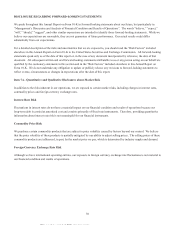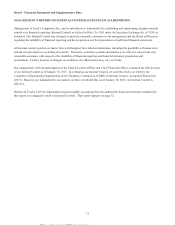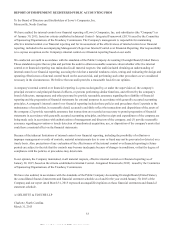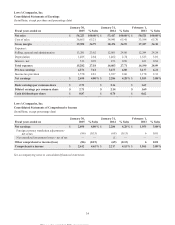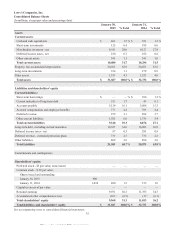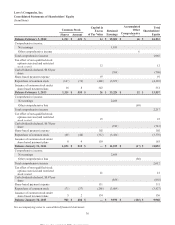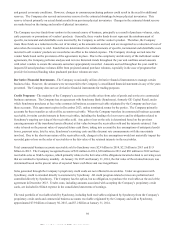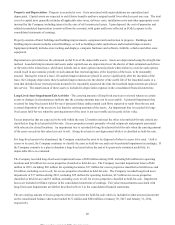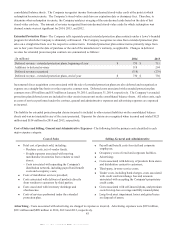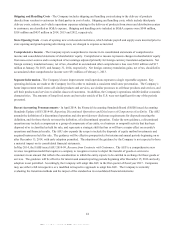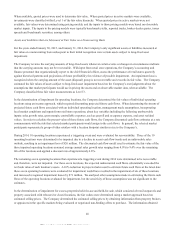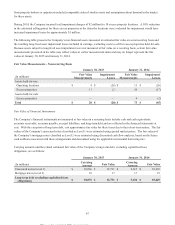Lowe's 2014 Annual Report Download - page 49
Download and view the complete annual report
Please find page 49 of the 2014 Lowe's annual report below. You can navigate through the pages in the report by either clicking on the pages listed below, or by using the keyword search tool below to find specific information within the annual report.and general economic conditions. However, changes in consumer purchasing patterns could result in the need for additional
reserves. The Company also records an inventory reserve for the estimated shrinkage between physical inventories. This
reserve is based primarily on actual shrink results from previous physical inventories. Changes in the estimated shrink reserve
are made based on the timing and results of physical inventories.
The Company receives funds from vendors in the normal course of business, principally as a result of purchase volumes, sales,
early payments or promotions of vendors’ products. Generally, these vendor funds do not represent the reimbursement of
specific, incremental and identifiable costs incurred by the Company to sell the vendor’s product. Therefore, the Company
treats these funds as a reduction in the cost of inventory as the amounts are accrued, and are recognized as a reduction of cost of
sales when the inventory is sold. Funds that are determined to be reimbursements of specific, incremental and identifiable costs
incurred to sell vendors’ products are recorded as an offset to the related expense. The Company develops accrual rates for
vendor funds based on the provisions of the agreements in place. Due to the complexity and diversity of the individual vendor
agreements, the Company performs analyses and reviews historical trends throughout the year and confirms actual amounts
with select vendors to ensure the amounts earned are appropriately recorded. Amounts accrued throughout the year could be
impacted if actual purchase volumes differ from projected annual purchase volumes, especially in the case of programs that
provide for increased funding when graduated purchase volumes are met.
Derivative Financial Instruments - The Company occasionally utilizes derivative financial instruments to manage certain
business risks. However, the amounts were not material to the Company’s consolidated financial statements in any of the years
presented. The Company does not use derivative financial instruments for trading purposes.
Credit Programs - The majority of the Company’s accounts receivable arises from sales of goods and services to commercial
business customers. The Company has an agreement with Synchrony Bank (Synchrony), formerly GE Capital Retail, under
which Synchrony purchases at face value commercial business accounts receivable originated by the Company and services
these accounts. This agreement expires in December 2023, unless terminated sooner by the parties. The Company primarily
accounts for these transfers as sales of the accounts receivable. When the Company transfers its commercial business accounts
receivable, it retains certain interests in those receivables, including the funding of a loss reserve and its obligation related to
Synchrony's ongoing servicing of the receivables sold. Any gain or loss on the sale is determined based on the previous
carrying amounts of the transferred assets allocated at fair value between the receivables sold and the interests retained. Fair
value is based on the present value of expected future cash flows, taking into account the key assumptions of anticipated credit
losses, payment rates, late fee rates, Synchrony's servicing costs and the discount rate commensurate with the uncertainty
involved. Due to the short-term nature of the receivables sold, changes to the key assumptions would not materially impact the
recorded gain or loss on the sales of receivables or the fair value of the retained interests in the receivables.
Total commercial business accounts receivable sold to Synchrony were $2.4 billion in 2014, $2.2 billion in 2013 and $1.9
billion in 2012. The Company recognized losses of $38 million in 2014, $38 million in 2013 and $30 million in 2012 on these
receivable sales as SG&A expense, which primarily relates to the fair value of the obligations incurred related to servicing costs
that are remitted to Synchrony monthly. At January 30, 2015 and January 31, 2014, the fair value of the retained interests was
determined based on the present value of expected future cash flows and was insignificant.
Sales generated through the Company’s proprietary credit cards are not reflected in receivables. Under an agreement with
Synchrony, credit is extended directly to customers by Synchrony. All credit program-related services are performed and
controlled directly by Synchrony. The Company has the option, but no obligation, to purchase the receivables at the end of the
agreement in December 2023. Tender costs, including amounts associated with accepting the Company’s proprietary credit
cards, are included in SG&A expense in the consolidated statements of earnings.
The total portfolio of receivables held by Synchrony, including both receivables originated by Synchrony from the Company’s
proprietary credit cards and commercial business accounts receivable originated by the Company and sold to Synchrony,
approximated $7.9 billion at January 30, 2015, and $7.2 billion at January 31, 2014.
39
This proof is printed at 96% of original size
This line represents final trim and will not print



